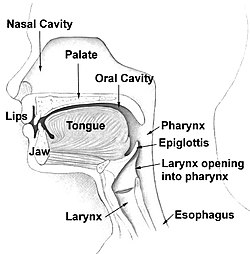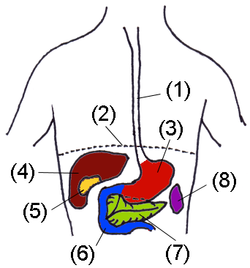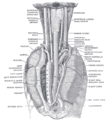Esophagus
"Gullet" redirects here. For the African sailboat, see Gulet. For the Dutch soccer coach, seeRuud Gullit.
"Weasand" redirects here. For other meanings, see Weasand (disambiguation).
| This article needs additional citations for verification. Please help improve this article by adding reliable references. Unsourced material may be challenged and removed. (December 2007) |
| Esophagus | |
|---|---|
 | |
| Head and neck. | |
 | |
| Digestive organs. (Esophagus is #1) | |
| Latin | œsophagus |
| Gray's | subject #245 1144 |
| Artery | esophageal arteries |
| Vein | esophageal veins |
| Nerve | celiac ganglia, vagus[1] |
| Precursor | Foregut |
| MeSH | oesophagus |
| Dorlands/Elsevier | Esophagus |
The esophagus (or oesophagus ) is an organ invertebrates which consists of a muscular tube through which food passes from the pharynx to the stomach. During swallowing food passes from the mouth through the pharynx into the esophagus and travels viaperistalsis to the stomach. The word esophagus is derived from the Latin œsophagus, which derives from the Greek word oisophagos , lit. "entrance for eating." In humans the esophagus is continuous with thelaryngeal part of the pharynx at the level of the C6vertebra. The esophagus passes through posterior mediastinum in thorax and enters abdomen through a hole in the diaphragm at the level of the tenth thoracic vertebrae (T10). It is usually about 25–30 cm long and connects the mouth to the stomach. It is divided into cervical, thoracic and abdominal parts. Due to theinferior pharyngeal constrictor muscle, the entry to the esophagus opens only when swallowing or vomiting.
Contents[hide] |
Histology
The layers of the esophagus are as follows:[2]
- mucosa
- nonkeratinized stratified squamous epithelium: is rapidly turned over, and serves a protective effect due to the high volume transit of food,saliva and mucus.
- lamina propria: sparse.
- muscularis mucosae: smooth muscle
- submucosa: Contains the mucous secreting glands (esophageal glands), and connective structures termed papillae.
- muscularis externa (or "muscularis propria"): composition varies in different parts of the esophagus, to correspond with the conscious control over swallowing in the upper portions and the autonomic control in the lower portions:
- upper third, or superior part:striated muscle
- middle third, smooth muscle andstriated muscle
- inferior third: predominantly smooth muscle
- adventitia
Esophageal constrictions
- At the esophageal inlet, where the pharynx joins the esophagus, behind the cricoid cartilage (14-16 cm from the incisor teeth).
- Where its anterior surface is crossed by the aortic arch and the left bronchus (25-27 cm from the incisor teeth).
- Where it pierces the diaphragm (36-38 cm from the incisor teeth).
The distances from the incisor teeth are important as is useful for diagnostic endoscopic procedures.
Gastroesophageal junction
The junction between the esophagus and the stomach (the gastroesophageal junction or GE junction) is not actually considered a valve, although it is sometimes called the cardiac sphincter,cardia or cardias, it actually better resembles a structure.
In much of the gastrointestinal tract, smooth muscles contract in sequence to produce a peristaltic wave which forces a ball of food (called a bolus) while in the esophagus. In humans, peristalsis is found in the contraction of smooth muscles to propel contents through the digestive tract.
In other animals
In most fish, the esophagus is extremely short, primarily due to the length of the pharynx (which is associated with the gills). However, some fish, including lampreys, chimaeras, and lungfish, have no true stomach, so that the esophagus effectively runs from the pharynx directly to the intestine, and is therefore somewhat longer.[5]
In tetrapods, the pharynx is much shorter, and the esophagus correspondingly longer, than in fish. Inamphibians, sharks and rays, the esophageal epithelium is ciliated, helping to wash food along, in addition to the action of muscular peristalsis. In the majority of vertebrates, the esophagus is simply a connecting tube, but in birds, it is extended towards the lower end to form a crop for storing food before it enters the true stomach.[5]
A structure with the same name is often found in invertebrates, including molluscs and arthropods, connecting the oral cavity with the stomach















No comments:
Post a Comment